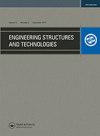COMPARATIVE ANALYSIS OF THE BUCKLING FACTOR OF THE STEEL ARCH BRIDGES
引用次数: 1
Abstract
The dominant axial compressive force makes the arches become extremely sensitive to the loss of stability. Their stability analysis was first initiated in the late 20th century. The first stability research of single arches was carried out inplane at the elastic stage of the arches. Later the behaviour of arches in the elastic-plastic stage, the initial stresses and geometric imperfections before the arch buckles were also assessed, the effective length of the arches and the out-of-the-plane arch strength conditions were being identified as well as the effect of the temperature on the stability of the arch. The expression of the critical force of the arches connected by vertical hangers with a chord and its dependant elements were defined by Petersen in the late 20th century. The design methodology for the formal design of arches connected by vertical hangers with a stiffening girder is presented in Annex D of the Eurocode 1993-2. Nevertheless, the area of application and the main assumptions are not defined. The first part of the comparative analysis identifies the assumptions for arch bridge modelling under which the buckling factor β dependence curves in Figure D.4 of Annex D to Eurocode 1993-2 can be applied. In the second part a comparison of the the normative βEC factor value and the one established by the numerical experiment with the increase in the number of hangers and change in the hanger network form is presented.钢拱桥屈曲系数的对比分析
占主导地位的轴向压缩力使拱对失稳变得极为敏感。他们的稳定性分析最初是在20世纪后期开始的。首次在单拱弹性阶段进行了单拱面内稳定性研究。随后对拱在弹塑性阶段的行为、拱屈曲前的初始应力和几何缺陷进行了评估,确定了拱的有效长度和拱的面外强度条件,以及温度对拱稳定性的影响。由带弦的垂直吊架连接的拱形及其相关元素的临界力的表达是由Petersen在20世纪后期定义的。由带有加劲梁的垂直吊架连接的拱形的正式设计方法见欧洲规范1993-2的附件D。然而,应用领域和主要假设没有定义。对比分析的第一部分确定了拱桥建模的假设,在这些假设下,欧洲规范1993-2附件D图D.4中的屈曲系数β依赖曲线可以应用。第二部分给出了随着吊架数量的增加和吊架网络形式的变化,规范β - ec因子值与数值实验所得β - ec因子值的比较。
本文章由计算机程序翻译,如有差异,请以英文原文为准。
求助全文
约1分钟内获得全文
求助全文

 求助内容:
求助内容: 应助结果提醒方式:
应助结果提醒方式:


